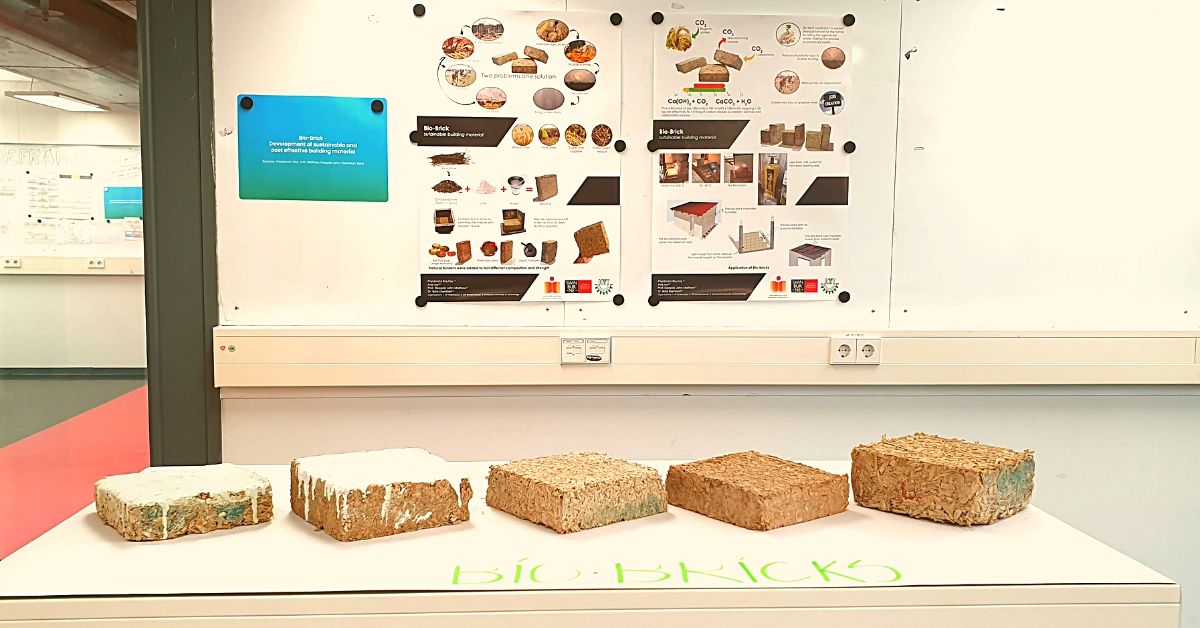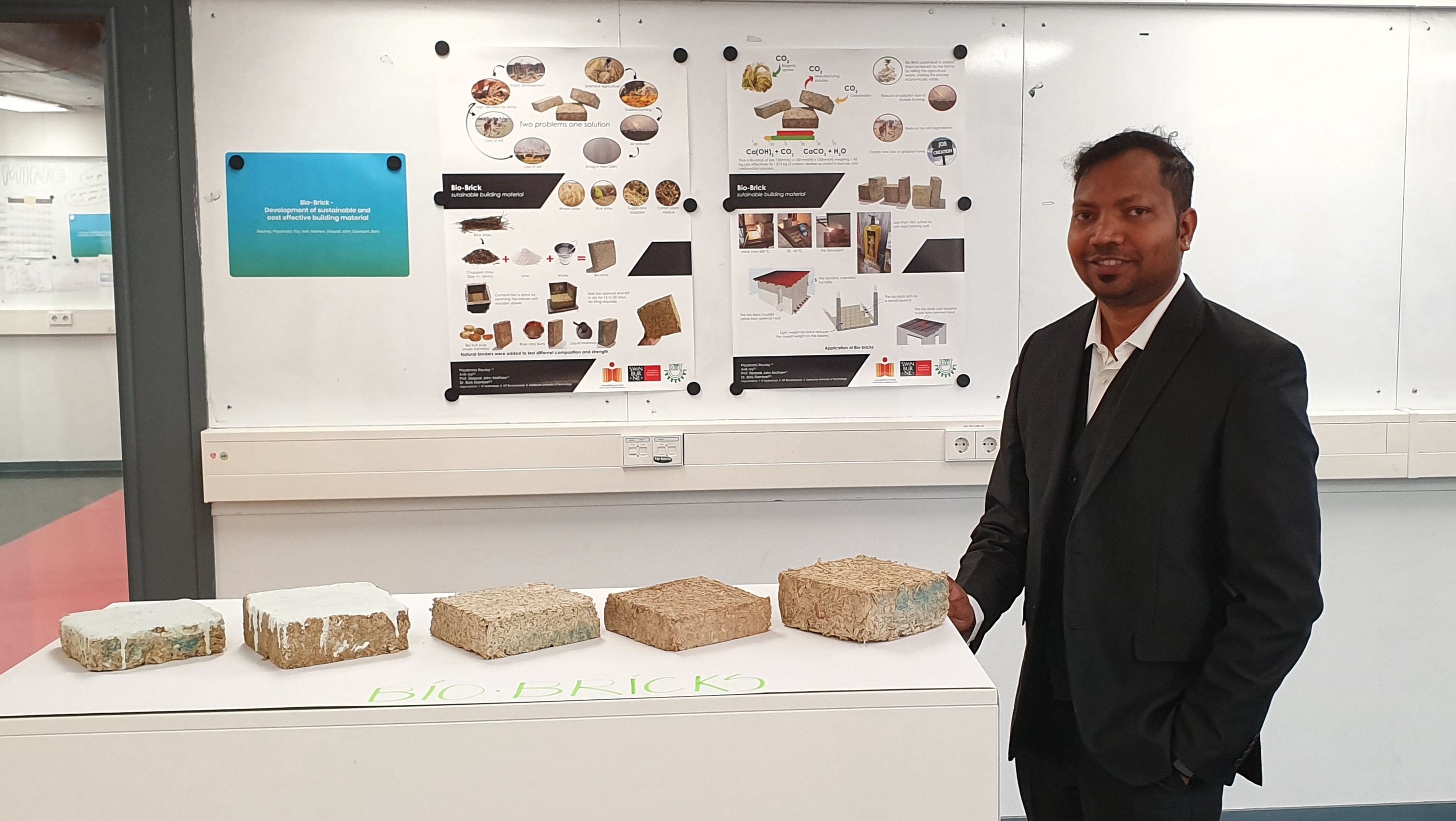Bio-Bricks Instead of Burning: IIT-H, KIIT Researchers Show How To Use Agro Waste
“Bio-bricks are not only more sustainable than clay bricks, but are also carbon sinks because they fix more carbon dioxide than they produce during their lifecycle." #IIT #Innovation

There is no question that the construction sector massively contributes to global warming.
In India itself, the industry emits 22% of the total annual CO2 emissions. And then there is agricultural waste—the country produces more than 500 million tons of it every year. While some of the waste is used as fodder, approximately 141 million tons are burnt every year.
Every time you inhale, you are breathing in dust, particulate matter, and much more. Give yourself the much need respite from air pollution, with these respiratory nasal filters.
Evidently, all this pollution takes a heavy toll on the environment and human health.
Fortunately, architects Priyabrata Rautray, who is also a PhD scholar in IIT Hyderabad’s Design Department, and Avik Roy, an Assistant Professor at the KIIT School of Architecture, Bhubaneshwar, have come up with a unique solution.
They have developed bio-bricks for construction from agricultural waste products. This innovation addresses both waste management and development of eco-friendly, sustainable building materials.
Guidance for the project came from Prof Deepak John Mathew, Head, Design Department, IIT Hyderabad and Dr Boris Eisenbart from Swinburne University of Technology, Australia.

“Bio-bricks or agro-waste based bricks act as good heat and sound insulators and also have an overall negative carbon footprint. Additionally, they are also a deterrent to stubble burning, prevalent in northern India, which causes severe air pollution. Due to their low density, they reduce the dead load in high rise structures, thereby making RCC construction more economical,” they claim in a recent paper published by the Cambridge University Press.
Why not use clay bricks instead?
“Clay bricks not only use up fertile topsoil, but their manufacturing process also emits significant amounts of carbon dioxide into the atmosphere,” explains Priyabrata.
How are these bio-bricks made?
“The process of making bio-bricks starts with careful selection of the dry agro-waste like paddy straws, wheat straws, sugarcane bagasse and cotton plant. The team decided to use dry sugarcane bagasse for the first sample. The bagasse is first chopped to the desired size. A lime-based slurry is prepared, and the chopped agro-waste is added to the slurry and mixed thoroughly by hand or mechanical mixer, to create a homogenous mixture. This mixture is poured into moulds and rammed with a wooden block to make a compact brick. These moulds are left to dry for a day or two, after which their sides are removed, and the brick is allowed to dry for fifteen to twenty days. It takes approximately a month for these bio-bricks to attain its working strength by air drying,” says a recent press release issued by IIT Hyderabad, via email.

To make a single block, 900 grams of sugar bagasse is used, but if this waste were to be burnt, it would release 639 grams of carbon dioxide, they claim. Moreover, the lime content in each brick allows it to absorb 322.2 grams of CO2 from the air during the curing process.
“Bio-bricks are not only more sustainable than clay bricks, but are also carbon sinks because they fix more carbon dioxide than they produce during their lifecycle,” adds Professor Roy.
Admittedly, these bio-bricks aren’t as robust as their clay counterparts and are nonviable for structures that would carry massive amounts of load.
Nonetheless, the researchers believe that they are ideal for low-cost housing alongside a structural framework comprising of either steel or wood.
For the time being, both architects are looking to address design concerns to enhance its load-bearing capacity.

“Other than as bio-bricks, this material can be used as panel boards or insulation boards and designers we could explore such applications for this sustainable material,” adds Priyabrata.
By 2030, about 590 million people in India are expected to live in cities, and we will need massive investments in the field of housing.
Additionally, studies indicate that India’s raw material requirements are expected to be near 15 billion tonnes by 2030. Thus, we must find eco-friendly solutions.
Also Read: Dump the AC, Use These 3 Green Cooling Solutions While Building Your Home!
(Edited by Gayatri Mishra)
Like this story? Or have something to share? Write to us: [email protected], or connect with us on Facebook and Twitter.
If you found our stories insightful, informative, or even just enjoyable, we invite you to consider making a voluntary payment to support the work we do at The Better India. Your contribution helps us continue producing quality content that educates, inspires, and drives positive change.
Choose one of the payment options below for your contribution-
By paying for the stories you value, you directly contribute to sustaining our efforts focused on making a difference in the world. Together, let’s ensure that impactful stories continue to be told and shared, enriching lives and communities alike.
Thank you for your support. Here are some frequently asked questions you might find helpful to know why you are contributing?


This story made me
-
97
-
121
-
89
-
167











